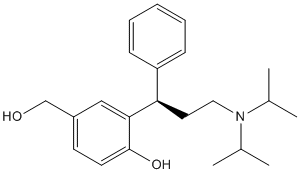
5-hydroxymethyl tolterodine (PNU 200577) is a potent and selective muscarinic receptor antagonist with a Kb and a pA2 of 0.84 nM and 9.14, respectively. 5-hydroxymethyl tolterodine (PNU 200577) is a major pharmacologically active metabolite of tolterodine. In vitro, PNU-200577 prevented carbachol-induced contraction of guinea-pig isolated urinary bladder strips in a competitive and concentration-dependent manner. In vivo, PNU-200577 was significantly more potent at suppressing acetylcholine-induced urinary bladder contraction than electrically induced salivation in the anaesthetised cat (ID50=15 and 40 nmol/kg, respectively). In radioligand binding studies carried out in homogenates of guinea-pig tissues and Chinese hamster ovary cell lines expressing human muscarinic m1-m5 receptors, 5-hydroxymethyl tolterodine (PNU 200577) was not selective for any muscarinic receptor subtype. Thus, 5-hydroxymethyl tolterodine (PNU 200577) is similar to tolterodine in terms of antimuscarinic potency, functional selectivity for the urinary bladder in vivo and absence of selectivity for muscarinic receptor subtypes in vitro. The results of this study clearly indicate that 5-hydroxymethyl tolterodine (PNU 200577) contributes to the therapeutic action of tolterodine, in view of its high antimuscarinic potency, similar serum concentration and lower degree of protein binding.
| Cell Experiment | |
|---|---|
| Cell lines | |
| Preparation method | |
| Concentrations | |
| Incubation time | |
| Animal Experiment | |
|---|---|
| Animal models | Male guinea-pigs |
| Formulation | Saline |
| Dosages | 2 nmol/kg -203 nmol/kg |
| Administration | Administered via i.v. |
| Molecular Weight | 341.49 |
| Formula | C22H31NO2 |
| CAS Number | 207679-81-0 |
| Form | Solid |
| Solubility (25°C) | DMSO 58 mg/mL |
| Storage |
Powder -20°C 3 years ; 4°C 2 years In solvent -80°C 6 months ; -20°C 1 month |
| Species | Mouse | Rat | Rabbit | Guinea pig | Hamster | Dog |
| Weight (kg) | 0.02 | 0.15 | 1.8 | 0.4 | 0.08 | 10 |
| Body Surface Area (m2) | 0.007 | 0.025 | 0.15 | 0.05 | 0.02 | 0.5 |
| Km factor | 3 | 6 | 12 | 8 | 5 | 20 |
| Animal A (mg/kg) = Animal B (mg/kg) multiplied by | Animal B Km |
| Animal A Km |
For example, to modify the dose of Compound A used for a mouse (20 mg/kg) to a dose based on the BSA for a rat, multiply 20 mg/kg by the Km factor for a mouse and then divide by the Km factor for a rat. This calculation results in a rat equivalent dose for Compound A of 10 mg/kg.
| Related AChR/AChE Products |
|---|
| Tacrine
Tacrine is a potent acetylcholinesterse (AChE) inhibitor (IC50=109 nM), also acting as a CYP1A2 substrate agent. |
| THRX-160209
THRX-160209 is a potent antagonist at the M(2) muscarinic acetylcholine (ACh) receptor subtype that was designed using a multivalent strategy, simultaneously targeting the orthosteric site and a nearby site known to bind allosteric ligands. |
| Catestatin
Catestatin is a 21-amino acid residue, cationic and hydrophobic peptide. |
| α-Conotoxin MII
α-Conotoxin MII (α-CTxMII), a 16-amino acid peptide from the venom of the marine snail Conus magus, potently blocks nicotinic acetylcholine receptors (nAChRs) composed of α3β2 subunits, with an IC50 of 0.5 nM. |
| COG 133 TFA
COG 133 TFA is a fragment of Apolipoprotein E (APOE) peptide. |


Products are for research use only. Not for human use. We do not sell to patients.
© Copyright 2010-2023 AbMole BioScience. All Rights Reserved.
